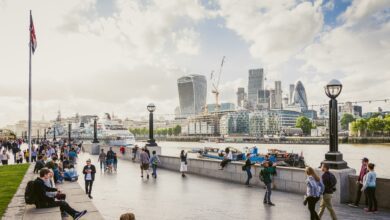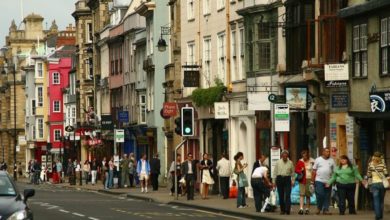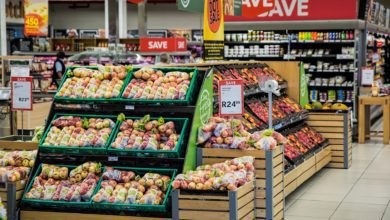Better than forecasted: how is Black Friday 2023 doing?
Jenni Matthews, marketing and insights director at MRI Software, told us what predictions the company has for Black Friday 2023

Register to get 1 free article
Reveal the article below by registering for our email newsletter.
Want unlimited access? View Plans
Already have an account? Sign in
According to last week’s release from MRI Software, Black Friday 2023 is going to be underwhelming for retailers compared to pre-pandemic levels. Does this still hold true? Can you expand further?
At MRI Software what we predicted last week was that Black Friday would weaken compared with previous years and that’s because of all the economic challenges that retailers face this year, as well as consumers. But what we’ve actually seen from Sunday the 19th up to yesterday (21 November) is an average 8.7% increase in footfall across all UK retail destinations.
For Black Friday itself we had forecasted a rise of 7.6% so at the moment we’re on track. It’s actually looking better than what we expected, particularly with high streets, which are doing really well and are up 12.6% from the week before. Shopping centres are up by 6.6% and retail parks by 2.6%.
On Friday, if we look at the year on year level, we expect footfall to rise 5.7% from last year, and then, versus 2019, it will probably remain at least 8% to 12% lower. As of today, we’re 3% higher than 2022 and 11.3% below 2019. I think it’d be interesting to see how the next two days pan out before we get to Black Friday itself.
What specific economic challenges are contributing to the subdued Black Friday sales forecast?
We know that this year consumer spending power is going to be much more restricted than in previous years and that comes off the back of higher household bills. The fixed rate mortgage for many came to an end over the summer period. So a lot of our consumers will be hit with an extra £400 a month which they may not have budgeted for this year. In addition, as we head into winter, we’ve got higher energy and heating bills. And yes, obviously off the back of last week, I knew that inflation has fallen, however this impact is going to be much longer term; I think in the short term, consumers are still going to feel the tension, unfortunately.
What changed between Black Friday 2022 and this year’s?
It comes back to the economic challenges. So, if we look back 12 months ago, a lot of consumers would have still had some savings that they would have gathered over the pandemic period when they weren’t able to go out and spend. And they probably hadn’t been hit by a lot of the higher household bills that came about this year. We have noticed footfall slowing down year on year throughout the course of the last 12 months and I think that is as a result of what’s going on in the economy.
Regarding retail destinations, are there any significant differences between high street retailers, shopping centres and retail parks?
We had predicted that shopping centre destinations could see the most significant increase in footfall, however high streets are performing better so far. Obviously, we’re expanding that cold snap towards the end of the week, so this could all change in the lead up to Friday. At the moment, we’re at the halfway point.
You mentioned that high streets are performing better than forecasted so far. Why is that the case?
We know that high streets and local town centres have had their Christmas lights switched on, Christmas markets being put out and a lot of local businesses are doing their own thing for the festivities as well. I think this is what drives a lot of footfall outdoors at the moment.
Has the shift to online shopping played a role in the weakening footfall performance on Black Friday?
Absolutely. The latest figures published by the ONS highlight that internet sales now account for 25.3% of total retail sales. Now, that’s positive for bricks and mortar destinations, because 75% of consumers are still preferring to shop in stores as opposed to online. However, that gradual shift to online shopping has risen year on year. And that happened even before the pandemic, I think the pandemic has probably accelerated that shift to online.
There’s a convenience factor, because people don’t have to go out and get everything delivered instead. Also, sometimes there may be better savings online as opposed to in store. I think this is something that retailers do need to be mindful of, what are the savings customers can get shopping in store versus online?
Considering the rise of online shopping, what do retailers have to keep in mind in order to attract customers for Black Friday?
They have to attract their customers by creating an in-store memorable experience for them. And consumers want to feel like they’re getting more of a saving at the store and not just a couple of pounds off. So retail destinations really need to be creative in attracting customers to their stores. And even though it’s going to be challenging for them, we still anticipate a rising footfall on Friday so there’s some encouraging news for them.
Do you think the Black Friday phenomenon will ever go back to pre-pandemic levels? Or is it destined to decline even further in the upcoming years?
It’s hard to say. At the moment, we can only comment on what we can see now. We’ve seen footfall weakened throughout this year compared to last year, however we have also seen peaks where footfall has risen from last year. In the end, I think it all depends on consumers’ disposable income as well as what retail destinations are doing to attract shoppers back.
So far, I think it’s really tricky to comment on what we think is going to happen in the next 12 months, now that inflation has dropped and it will definitely impact consumer spending.
Early signs
The half-day data for Black Friday 2023 (24 November) shows that footfall across all UK destinations is almost on par with midweek predictions, having risen 7.1% until 12pm. Regionally, Central London has seen the most significant rise with a 13.1% increase from last week and 1.5% boost compared with last year.
However, despite high streets outperforming all destinations midweek, the latest analysis shows that the largest rise has been seen at shopping centres, where footfall has increased 11.2% as shoppers make the most of free parking, large stores and hospitality options.
Jenni Matthews has welcomed the positive news, but reinstated that footfall remains 24% lower than 2019, suggesting that “we may not return to pre-pandemic levels for events such as Black Friday”.







